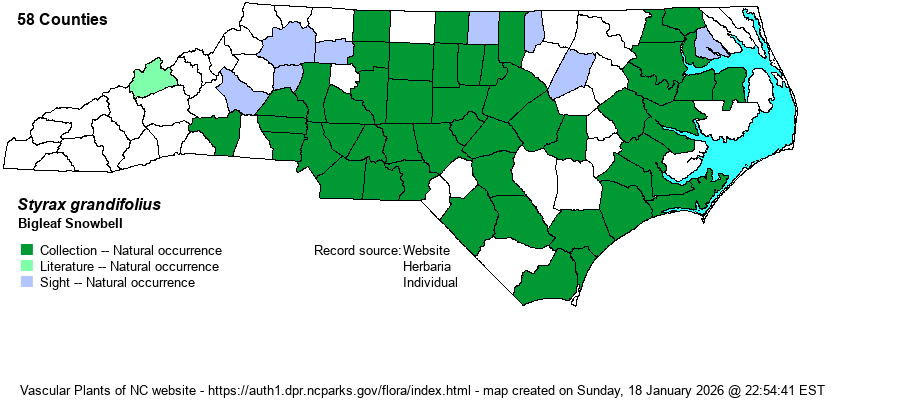| Author | Aiton | |
| Distribution | An odd bimodal distribution in the state. The main range is throughout the Piedmont, though scarce in the foothills. There is a narrow and real north-south gap in the range, for uncertain reasons, but it again appears in a north-south band through the east-central Coastal Plain, from Gates and Hertford counties on the north to Brunswick on the south. It is absent in far eastern counties; and it seems to be absent to extremely rare through most of the western Coastal Plain, including the Sandhills. There is a recent Research Grade photo from Madison County at low elevation in the Mountains.
This is a Southern species with odd holes in the range, such as in much of the Mississippi Valley and in montane areas. It ranges north to central VA and MO, and south to northern FL and eastern TX.
| |
| Abundance | It is fairly common to frequent in the Piedmont, except rare to absent in the foothills counties. In the Coastal Plain, it is uncommon to locally fairly common in the narrow north-south band, but rare to absent west and east of that band. | |
| Habitat | This is a species of fairly rich to mesic forested slopes, though not typically on circumneutral soils. In the Piedmont, it favors wooded slopes, mainly in Mesic Mixed Hardwood Forest, but can occur on bluffs as well, and along stream banks. In the central Coastal Plain, it favors a bit higher pH soils of slopes and bluffs (such as where creeks have dissected Coastal Plain clay soils); in some sites it probably does overlie circumneutral soils. It definitely is not a species of blackwater drainages or highly acidic soils (such as in the Sandhills). |
| Phenology | Blooms in April and May, and fruits in August and September. | |
| Identification | This is a rather familiar (at least to Piedmont biologists) deciduous large shrub or small tree, growing with a single stem to about 15-20 feet tall. It has a distinctive, dark gray to sooty, “leadpipe” trunk, which is rather smooth but has some bends in it. The end buds are naked and buff-colored, and thus it can be identified readily in winter. In spring, the numerous dangling white flowers, with five flared-back petals, are very conspicuous. The leaves are among the largest of the NC shrubs and small trees, being about 5 inches long and often 3-4 inches wide. Though widely elliptical, often with a few teeth, the leaf shape is seldom gently rounded but is angular with an odd shape; the tip is usually acuminate. Thus, the species normally is not a major identification challenge. | |
| Taxonomic Comments | As with Styrax americanus, that species and this one have had the “gender” changed in recent decades, from “-a” to “-us”.
| |
| Other Common Name(s) | Bigleaf Storax | |
| State Rank | S4 [S4S5] | |
| Global Rank | G5 | |
| State Status | | |
| US Status | | |
| USACE-agcp | FACU link |
| USACE-emp | FACU link |

